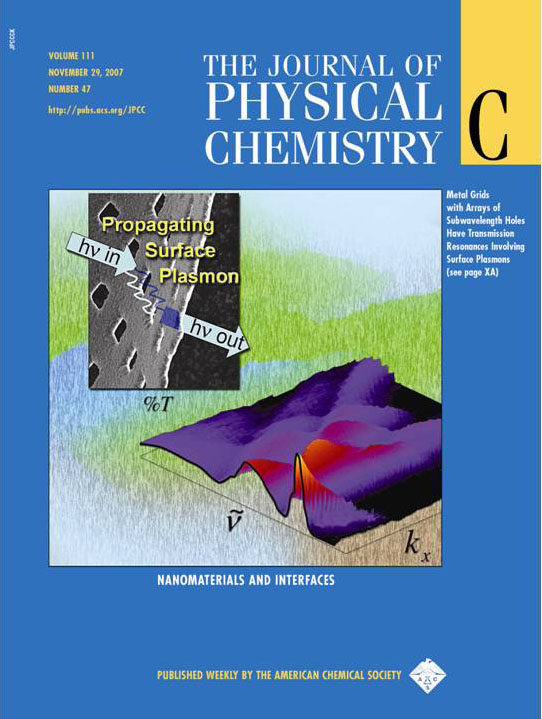
ACS PRF | ACS
All e-Annual Reports

42452-AC5
Collision-Induced-Stimulated-Emission using Surface Plasmons on Metal Microarrays: New Gain Medium for IR Lasers
Our program concerns metal films with arrays of subwavelength holes which support surface plasmon mediated transmission resonances. Our group has been developing applications of this phenomenon for chemistry, such as enhanced infrared absorption spectroscopy of molecules and monolayers at the metal interface. This grant was designed to investigate our initial reports of CO2 lines in emission when using metal films with arrays of subwavelength holes in the sample region of a standard FTIR instrument. We thought that these lines might be due to a nonlinear process at the surface of the mesh, but it turned out not to be so. We discovered that these lines were due to double-modulated light. Since the mesh is both transmitting and reflective, modulated light bounces off of mesh in the spectrometer's sample region and goes back into the spectrometer, and gets modulated again. Remarkably, some of this double-modulated light gets through the mesh and ends up on the detector. So this turns out to be a way to work with light that has been reflected perpendicularly to the surface, but there are no nonlinear processes involved. After understanding the subject phenomena, our strategy was to continue to look for other unusual properties of this new photonic metamaterial. In this grant period, we have published 6 papers which acknowledge support from the ACS PRF. These papers (such as the following four references) include the characterization of metal oxide nanocoating thickness with shifts of the surface plasmon transmission resonances, the interaction of surface plasmons with molecular vibrations, the use of doublestacks of mesh with no direct paths for transmission to get an “infinite” transmission enhancement, and the use of phospholipid monolayers to control the passage of polarized light through microchannels. So the grant did not proceed as expected, but was prolific with new discoveries.
K.R. Rodriguez, H. Tian, J.M. Heer, and J.V. Coe, "Extraordinary Infrared Transmission Resonances of Metal Microarrays for Sensing Nanocoating Thickness", J. Phys. Chem. C, 111 12106-12111 (2007).
K.R. Rodriguez, H. Tian, J.M. Heer, S. Teeters-Kennedy, and J.V. Coe, "Interaction of an infrared surface plasmon with an excited molecular vibration", J. Chem. Phys. 126 151101, 5 pps (2007).
S.M. Teeters-Kennedy, S.M. Williams, K.R. Rodriguez, K. Cilwa, D. Meleason, A. Sudnitsyn, F. Hrovat, and J.V. Coe, "Extraordinary Infrared Transmission of a Stack of Two Metal Micromeshes", J. Phys. Chem. C, (2007), 111, 124-130.
S.M. Teeters-Kennedy, K.R. Rodriguez, T.M. Rogers, K.A. Zomcheck, S.M. Williams, A. Sudnitsyn, L. Carter, V. Cherezo, M. Caffrey, and J.V. Coe, "Controlling the Passage of Light through Microchannels by Nanocoatings of Phospholipids", JPC B, 110(43) 21719-21727 (2006).
In addition to the regular papers, we were also invited to write articles for Annual Reviews in Physical Chemistry and a feature article for the Journal of Physical Chemistry C (including a cover). Both have now been published on the web. The former reviews the whole field of metal films with arrays of subwavelength holes while the latter is a review of our own work in the infrared region (including a paragraph on the original subject of this proposal).
J.V. Coe, J.M. Heer, S. Teeters-Kennedy, H. Tian, and K.R. Rodriguez, "Extraordinary Transmission of Metal Films with Arrays of Subwavelength Holes", Ann. Rev. Phys. Chem. 59 179-202 (2008).
J. V. Coe, K.R. Rodriguez, S. Teeters-Kennedy, K. Cilwa, J.M. Heer, and H. Tian, and S.M. Williams, "Metallic Arrays of Subwavength Holes: Spectroscopy with Infrared Plasmonic Scaffolding", J. Phys. Chem. A (2007) Featured Article, in press.
Our work was also presented in a Nature review by Genet and Ebbesen [“Light in Tiny Holes”, Nature 445 39-46 (2007)]. One of our spectra (formaldehyde adsorbed on copper oxide) was given in Fig. 7. Finally, work continues and we have discovered another catalytic reaction that can be studied at room temperature, in air, with a standard FTIR spectrometer (like our earlier work with the transformation of methanol to formaldehyde on copper oxide). We have two complete data sets for the conversion of benzyl alcohol to benzyl benzoate on both nickel oxide and gold. A draft manuscript is being improved for submission on the timescale of a few months. ACF PRF funding (both the previous grant and this one) has been invaluable for the development of this new program. While this grant supported three different graduate students and two undergraduates, it principally supported a Hispanic graduate student, Kenneth Rodriguez, who has since graduated. Her is now back in Los Angeles teaching at his undergraduate institution. The PI is grateful for this support. 